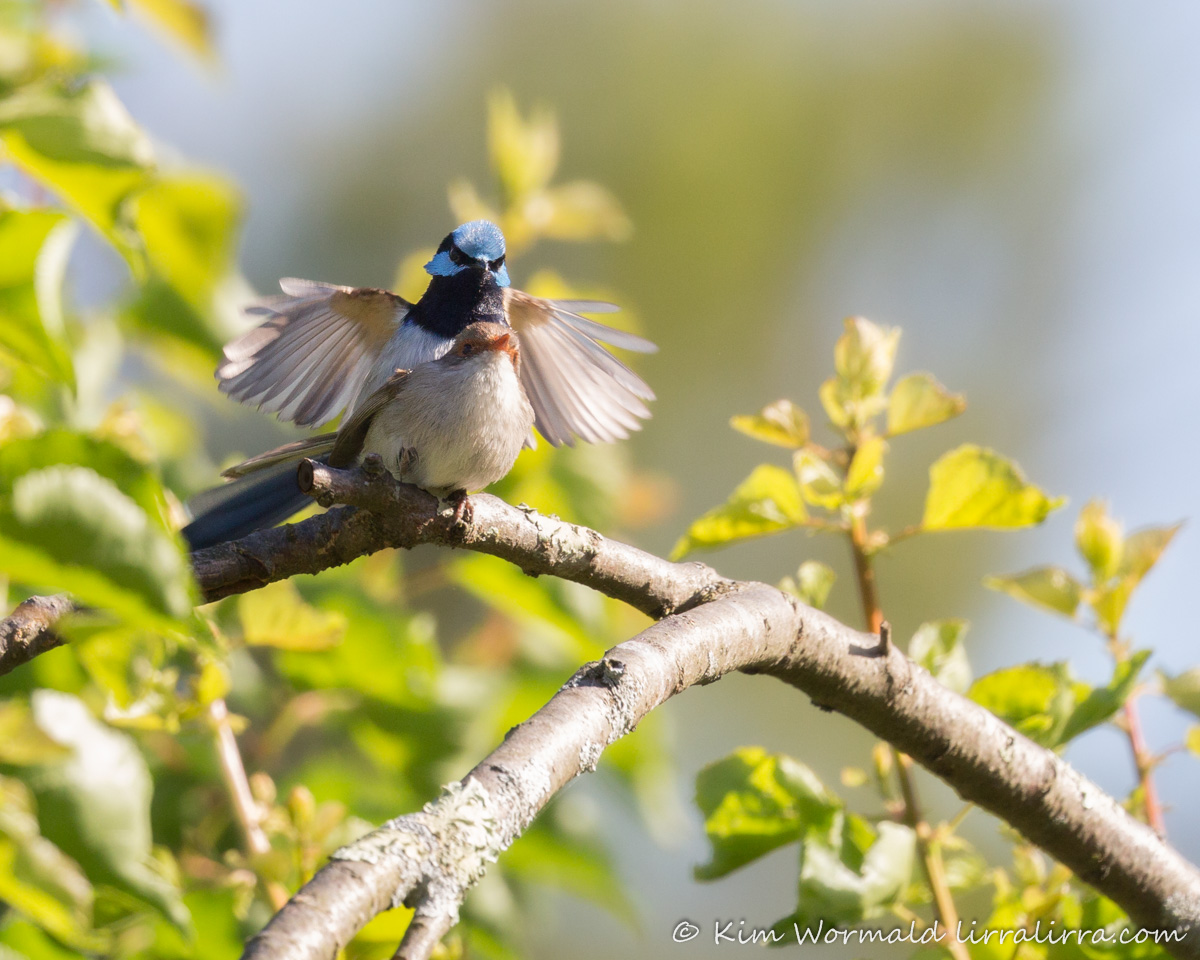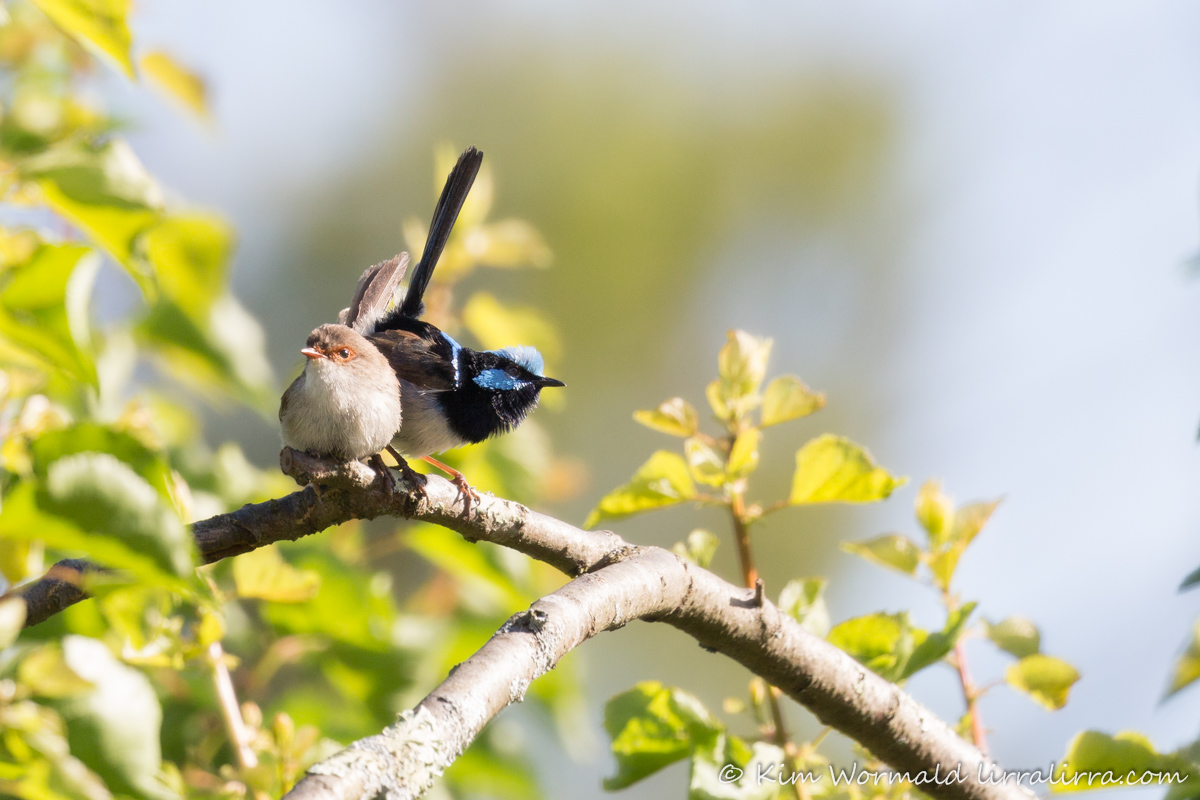I’ve been on several trips recently and have more new images than I can shake a monopod at; many of which I’m looking forward to sharing on lirralirra – Malleefowl are a definite highlight. In the meantime the spirit of spring prompted me to share this week’s images of fairy-wrens making fairy-wrens.
 Superb Fairy-wrens – male and female
Superb Fairy-wrens – male and female
The male called from the apricot tree and, as I was photographing him, the female arrived. At 08:54:10 the action began. All three of today’s images were taken at 08:54:10 – these birds don’t waste any time!

Superb Fairy-wrens – male and female
Superb Fairy-wrens nest on the ground where they are horribly vulnerable to attack from predators. Their nests are tiny balls with side entrances, made from grass stems, lined with feathers and generally hidden in long grass, reeds or ferns. They lay three or four speckled eggs that are incubated by the female for 14-16 days.

Superb Fairy-wrens – male and female
It’s good that an increasing number of councils are passing regulations requiring cats to be confined to their own properties, and that increasing numbers of cat owners are keeping their cats inside or creating indoor/outdoor cat enclosures. Several friends of mine have elaborate cat enclosures that protect their cats from fights, traffic and disease while also protecting wildlife – which is a good thing all round.
Happy birding, Kim
~ Thank you for visiting and commenting
~ If you would like a weekly email letting you know that lirralirra has been updated please use the ‘subscribe’ box above right

Birds on a mission to be sure! Nice images and so cool to know they are happy enough and safe enough to be breeding.
I hope they go well Sherry, I’ll keep lirralirra posted
Amazing photos Kim. Yesterday at World Vegan Day,I heard a wonderful speaker, Jonathan Balcombe,an animal behaviorist, who writes about the inner lives of animals. I purchased one of his books which contains a photo which I know you would appreciate of ‘house sparrows making house sparrows.’ Oh,how he would love to see your photos!
When I was travelling around NZ I worked for a farmer called Jon Balcombe, I doubt that it’s the same person. I’ll look out for his book, it sounds like fascinating reading.
Lovely photos, Kim.
Thank you Carole
My goodness your amazing Kim. just blows my mind at how quick you & your camera would have to be to get these superb shots. Beautiful.
Dona
If I hadn’t had the camera settings reasonable I would have missed the shots for sure. I’m glad you like them.
Wow, how amazing to get these shots!
I was very lucky. The lighting wasn’t perfect but at least they weren’t hiding among a pile of sticks as they were the last time I photographed fairy-wrens making fairy-wrens.
Given their ground nesting proclivities, it is a wonder that they are as successful as they are in suburbia!
That’s true Claire but unfortunately their numbers in the suburbs have significantly declined and continue to do so
How I love this series. Thank you.
And I am really looking forward to the Mallee Fowl post.
I’m glad you like the fairy-wrens EC. I hope I can post the Malleefowl soon, I’m looking forward to it too!
What wonderful pictures. You captured some nice behavior. I was at the University of Washington library yesterday, reading about Fairy-Wren’s social system. Thanks for sharing.
Tom
I have spent hours reading about their social behaviour too, it’s absolutely fascinating and not at all what we’d assume when looking at the ‘family group’. I mentioned it in earlier posts and should probably have mentioned it again in this one.
How fabulous to have these beauties in your garden. I love the way the male’s blue ‘cheeks’ seem to puff out when they were mating. Fabulous shots. Thanks for sharing, Kim.
from
(another) Kim
Hi (another) Kim, what a great name you have. The male fairy-wren does look pretty pleased with himself. I’ve just visited your website and thoroughly enjoyed reading about native bees and watching the caterpillar video, absolutely brilliant, thank you!
Thank-you so much for taking the time to look at my BLOG. I am not a very good blogger as far as keeping it up but I hope others find it interesting as I do when I do get it done. Keep up the good work here!
Looking at your blog was my pleasure!